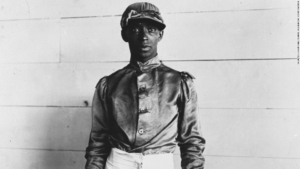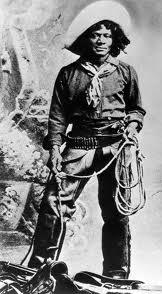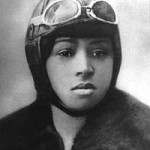The Forgotten Girls Who Led the School-Desegregation Movement
Before the 9-year-old Linda Brown became the lead plaintiff in Brown v. Board of Education, a generation of black girls and teens led the charge against the “separate but equal” doctrine in public schools.
Photo: Millicent Brown, left, 15, daughter of state NAACP President J. Arthur Brown, one of two black girls to enter Rivers High School in Charleston, S.C, chats with fellow students while awaiting a report from police and fireman concerning a bomb scare at the school on Sept. 3, 1963. (AP Photo)
(The Atlantic) There’s an enduring myth that the 1954 Brown v. Board of Education decision was “the first step” in the fight to desegregate schools. Rachel Devlin, an associate professor of history at Rutgers University, is looking to upend that myth. A Girl Stands At The Door, her new account of the black girls and teens who laid the groundwork for the historic ruling, draws from interviews and archival research to show that before Linda Brown, a 9-year-old, became the lead plaintiff in the Supreme Court case, a generation of black girls and young women from the Deep South to the Midwest fueled the grassroots crusade to strike down the “separate but equal” doctrine in America’s public schools and colleges.
Before Brown, some dozen lawsuits were filed on behalf of young black women attempting to enroll in all-white schools—and after Brown, black girls, almost exclusively, did the hard labor of walking through all-white mobs and sitting in previously all-white classrooms, with sometimes hostile classmates and teachers, in pursuit of school integration. (more)
The Disappearance Of The African-American Jockey
(Forbes.com) Justify won the Triple Crown on Saturday, making him only the 13th horse since 1919 to win the Triple Crown (and only the second since 1978). And for one day, horse racing might have been the biggest horse story in America. But after this past weekend, the attention of sports fans will quickly move on to other sports. So perhaps while attention lingers on horse racing, this is a good time to briefly review some history in the sport.
Once upon a time, horse racing was huge. In fact, in the latter part of the 19th century, horse racing was likely the biggest sport in America. And after the horses (of course), the sports stars were the jockeys.
Isaac Burns Murphy was one of these early stars. As noted by Olivia Waxman, Murphy won the Kentucky Derby in 1884, 1890 and 1891 — the first jockey to win this race three times. Waxman goes on to note that Murphy’s success led to a yearly salary between $15,000 and $20,000, or nearly $1 million in today’s dollars.
Joe Drape, author of “Black Maestro,” told CNN: “Murphy was the first millionaire black athlete. He even had a white valet.”
Murphy was not the only African-American jockey in that era. In fact, African-American jockeys at this time were quite common. (more)
 Related book: “The Prince of Jockeys: The Life of Isaac Burns Murphy,” by Pellom McDaniels III
Related book: “The Prince of Jockeys: The Life of Isaac Burns Murphy,” by Pellom McDaniels III
The first definitive biography of this celebrated athlete, whose life spanned the Civil War, Reconstruction, and the adoption of Jim Crow legislation. Despite the obstacles he faced, Murphy became an important figure—not just in sports, but in the social, political, and cultural consciousness of African Americans. Drawing from legal documents, census data, and newspapers, this comprehensive profile explores how Murphy epitomized the rise of the black middle class and contributed to the construction of popular notions about African American identity, community, and citizenship during his lifetime.
Descendants of Last Slave Ship Still Live in Alabama Community
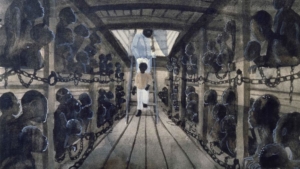
The slave trade in the former West African colonies of ships carrying black captives to America. (Credit: DeAgostini/Getty Images)
(History.com) For most black Americans descended from enslaved Africans, there’s no way of tracing back where their ancestors came from. There’s also no way of discovering, as Malcolm X emphasized, their “true family name.” The slave trade ripped families apart, and records from slave ships and plantations often identified enslaved people with multiple or incomplete names. It’s extremely difficult to connect the freed black Americans first named on the 1870 census to their enslaved ancestors—a problem known as the 1870 Brick Wall.
Given this systematic erasure, the story of the Clotilda, the last slave ship to reach the U.S., occupies a profoundly unique place in the history of the transatlantic slave trade.
There were roughly 110 African children, teenagers, and young adults on board the Clotilda when it arrived in Alabama in 1860, just one year before the Civil War. Unable to return to Africa after emancipation on June 19, 1865—aka Juneteenth—they left records and gave interviews about who they were and where they came from that survive today. (more)
TIPHC Bookshelf
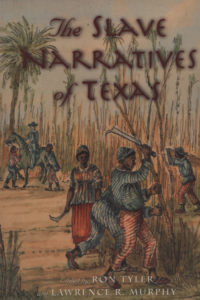 Before Brown book coverPublished scholarship on black history in Texas is growing and we’d like to share with you some suggested readings, both current and past, from some of the preeminent history scholars in Texas and beyond. We invite you to take a look at our bookshelf page – including a featured selection – and check back as the list grows. A different selection will be featured each week. We welcome suggestions and reviews. This week, we offer, “The Slave Narratives of Texas,” edited by Ron C. Tyler and Lawrence R. Murphy.
Before Brown book coverPublished scholarship on black history in Texas is growing and we’d like to share with you some suggested readings, both current and past, from some of the preeminent history scholars in Texas and beyond. We invite you to take a look at our bookshelf page – including a featured selection – and check back as the list grows. A different selection will be featured each week. We welcome suggestions and reviews. This week, we offer, “The Slave Narratives of Texas,” edited by Ron C. Tyler and Lawrence R. Murphy.
Many defenders of slavery have maintained that the slaves in Texas were well-treated and happy, but as a former slave remarked, “Tisn’t he who has stood and looked on, that can tell you what slavery is—’tis he who has endured.” Here are the tales of those who have endured—a collection of the voices of the ex- slaves themselves, recalling what their lives were like under slavery. Over one hundred former slaves describe their slavemasters, their work, runaway slaves, their recollections of the Civil War and, finally, the coming of freedom. The narratives were collected by WPA interviewers in the late 1930s and subsequently edited by Ron Tyler and Lawrence R. Murphy. The Slave Narratives of Texas is a highly informative and readable book that provides a valuable history of the institution of slavery in Texas. It is also a profoundly moving text which yields great insight into the full impact of slavery upon human lives.
This Week in Texas Black History
Jun 11
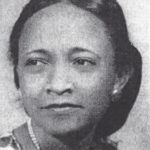 On this day in 1991, Connie Yerwood died in Austin. In 1937, she became the first African American doctor to work for Texas Public Health Services. The Victoria native would also become the first black director of Maternal and Child Services in Texas and the first black chief of the Bureau of Personal Health Services. Yerwood was a long-time trustee of Samuel Huston College and the national president of its National Alumni Association.
On this day in 1991, Connie Yerwood died in Austin. In 1937, she became the first African American doctor to work for Texas Public Health Services. The Victoria native would also become the first black director of Maternal and Child Services in Texas and the first black chief of the Bureau of Personal Health Services. Yerwood was a long-time trustee of Samuel Huston College and the national president of its National Alumni Association.
Jun 12
 James Leonard Farmer, Sr., who normally wrote his name “J. Leonard Farmer” on all of his publications, was born on this date in Kingstree, South Carolina in 1886. Farmer became Texas’ first black professor with an earned Ph.D (Boston University 1918), pastored churches in Texarkana, Marshall and Galveston and taught at Wiley College in Marshall (1919-20 and 1934-39) and Samuel Huston (later Huston-Tillotson) (1925-30 and 1946-56), in Austin. His son, James Farmer, Jr., was a noted Civil Rights activist and founder of CORE and was one of Wiley’s “Great Debators.”
James Leonard Farmer, Sr., who normally wrote his name “J. Leonard Farmer” on all of his publications, was born on this date in Kingstree, South Carolina in 1886. Farmer became Texas’ first black professor with an earned Ph.D (Boston University 1918), pastored churches in Texarkana, Marshall and Galveston and taught at Wiley College in Marshall (1919-20 and 1934-39) and Samuel Huston (later Huston-Tillotson) (1925-30 and 1946-56), in Austin. His son, James Farmer, Jr., was a noted Civil Rights activist and founder of CORE and was one of Wiley’s “Great Debators.”
Jun 14
In 1854, on this date, famous cowboy Nat Love, “Deadwood Dick,” was born as a slave on Robert Love’s plantation in Davidson County Tennessee. (Nat is pronounced “Nate.”) Love became proficient at breaking horses, and at age 15, headed west with $50 in his pocket to seek work as a cowboy. In Dodge City, Kansas, he met the crew of the Duval Ranch at the conclusion of their cattle drive and returned with them to Texas to work at the ranch. The teenager quickly adapted to cowboy life and excelled as a ranch hand and a marksman with his .45 revolver. He earned the name, “Deadwood Dick,” after winning an all-around cowboy contest in Deadwood, S.D. The contestants competed in roping, bridling, saddling, and shooting and Love finished first in each category, walking away with the $200 prize and a new nickname.
Jun 15-16
On these days in 1943, the Beaumont Riots occurred. Conditions in the city were already tense because blacks and whites were competing for jobs in the shipyards because of World War II and because of a lack of enough resources, traditionally segregated facilities were forced to integrate. The situation escalated when a white woman reported being raped by a black man, though she was unable to identify the suspect being held at the city jail. However, on the evening of June 15 more than 2,000 workers, plus perhaps another 1,000 interested bystanders, marched toward City Hall, then dispersed into small bands and began breaking into stores in the black section of downtown Beaumont. With guns, axes, and hammers, they proceeded to terrorize black neighborhoods in central and north Beaumont. Many blacks were assaulted, several restaurants and stores were pillaged, a number of buildings were burned, and more than 100 homes were ransacked. More than 200 people were arrested, fifty were injured, and two – one black and one white – were killed. Another black man died several months later of injuries received during the riot. Beaumont was among several U.S. cities that experienced violent race riots that summer, including Detroit, Harlem, and Mobile, Ala.
See news video here: “Beaumont race riot remains etched into collective memory of Southeast Texas for almost 75 years”
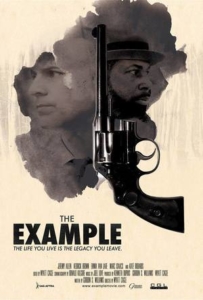 Movie: “The Example” is a historical fiction version of the event following two fathers who make difficult decisions to protect their families during the riots, forcing them to question their morals, loyalty and manhood. The film has won several awards, including: “First Place” in the Short Film Category at the Highway 61 Film Festival and “Best Drama” at The Gulf Coast Film & Video Festival. The film’s writer and producer is Gordon S. Williams, a Cleveland, Texas native and 1998 graduate of Lamar University (Beaumont). He also heads G Sharp Productions. Click here for more information, including a trailer for the movie.
Movie: “The Example” is a historical fiction version of the event following two fathers who make difficult decisions to protect their families during the riots, forcing them to question their morals, loyalty and manhood. The film has won several awards, including: “First Place” in the Short Film Category at the Highway 61 Film Festival and “Best Drama” at The Gulf Coast Film & Video Festival. The film’s writer and producer is Gordon S. Williams, a Cleveland, Texas native and 1998 graduate of Lamar University (Beaumont). He also heads G Sharp Productions. Click here for more information, including a trailer for the movie.
Jun 15
On this date in 1921, Bessie Coleman, from Atlanta, Texas, became the first licensed black pilot in the world when she earned an international aviation license from the Federation Aeronautique Internationale. As a barnstorming stunt pilot, she became known as “Queen Bess” and “Brave Bessie.” In 1995, the U.S. Postal Service issued a stamp in Bessie’s honor and in 2000 she was inducted into the Texas Aviation Hall of Fame. The main road to Atlanta’s airport is named Bessie Coleman Drive.
Blog: Ron Goodwin, Ph.D., author, PVAMU history professor
Ron Goodwin is an assistant professor of history at Prairie View A&M University. Even though he was a military “brat,” he still considers San Antonio home. Like his father and brother, Ron joined the U.S. Air Force and while enlisted received his undergraduate degree from Texas Lutheran University in Seguin, Texas. After his honorable discharge, he completed graduate degrees from Texas Southern University. Goodwin’s book, Blacks in Houston, is a pictorial history of Houston’s black community. His most recent book, Remembering the Days of Sorrow, examines the institution of slavery in Texas from the perspective of the New Deal’s Slave Narratives.
Recent Posts
King of Kings
During his lifetime Martin Luther King consistently paralleled the experiences of the biblical Children of Israel and the experiences of Africans in America. As a result, he thrust himself into the role of Moses. What I find interesting in these parallels was the ultimate goal of the story. The Children of Israel, after 400 years of bondage, eventually made their way to the Promised Land. This was the message that I believe King was ultimately…
Wakanda Forever — Part 2
The internet records the following regarding the financial success of the Black Panther as of March 25, 2018: Receipts grossed $631.4 million in the US and Canada and a worldwide total of $1.239 billion; The film made $370.5 million worldwide in its opening weekend (the 15th largest of all time); Thus far, Black Panther is the highest-grossing solo superhero film and the 3rd third highest-grossing movie in the Marvel Cinematic Universe (MCU); and In only five weeks after…
Submissions wanted
Historians, scholars, students, lend us your…writings. Help us produce the most comprehensive documentation ever undertaken for the African American experience in Texas. We encourage you to contribute items about people, places, events, issues, politics/legislation, sports, entertainment, religion, etc., as general entries or essays. Our documentation is wide-ranging and diverse, and you may research and write about the subject of your interest or, to start, please consult our list of suggested biographical entries and see submission guidelines. However, all topics must be approved by TIPHC editors before beginning your research/writing.
We welcome your questions or comments. Please contact Mr. Michael Hurd, Director of TIPHC, at mdhurd@pvamu.edu.

